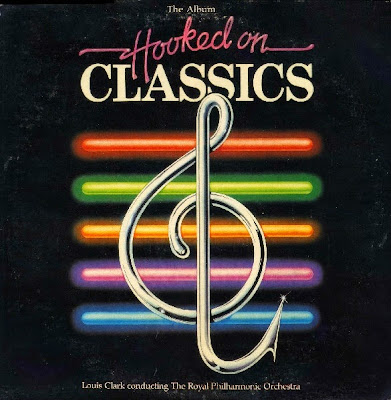History's Dumpster Mobile Link
History's Dumpster for Smartphones, Tablets and Old/Slow Computers http://historysdumpster.blogspot.com/?m=1
Monday, July 06, 2015
Tuesday, May 05, 2015
"Hooked On Classics" The Royal Philharmonic Orchestra (K-Tel/RCA, 1981)
When you think of classical music, K-Tel isn't exactly the first name that comes to mind.
K-Tel, as everyone knows, was the purveyor of microgroove albums of all the pop hits that's print to fit. So what was K-Tel doing messing around with classical music?
The story begins in the UK at the height of the Stars On 45 fad. Louis Clark, former arranger of Electric Light Orchestra had an idea of making a similar medley album, using recognizable pieces of classical music linked together with a disco beat. He thought it could re-energize the classical genre the way the Stars On 45 helped re-energize the Beatles catalog for a new generation. He found an unlikely supporter and partner in K-Tel UK.
 |
| UK pressing of Hooked On Classics |
While classical purists loudly condemned this practice, it's worth noting that there was a side benefit. Classical music even then was largely dying as fewer young people were exposed to the music. These albums, for all their campiness and unconventional approaches did introduce classical elements to a newer generation. It may not be your grandpa's classical music, but they illustrated what could be done with it in contemporary music. If they only got that far it was worth it as classical music, while still an increasingly obscure genre and long vanished off commercial radio, is still very much alive and it's influence still occasionally pops up now and then in contemporary pop and rock music.
Hooked On Classics was released in the UK and became a phenomenal smash hit. However in the US, K-Tel needed to get this out to real record stores, as most of K-Tel's product was sold in discount stores. And to the radio stations. RCA had all these connections. So they arranged a distribution deal through RCA Records in the US.
 |
| This is K-Tel's only originally produced US Top 40 hit single, making it to #10 in February of 1982. |
Hooked On Classics spawned two sequel albums, each selling far less than the first in 1982 and 1983.
Labels:
1970s,
1980s,
Lost Pop Classic,
Music,
Novelty,
Pop,
Promotional,
Radio,
Records,
Rock
Thursday, April 30, 2015
"The Captain Of Her Heart" Double (1985)
Listen
This song will save you $$$ in air conditioning costs. Just the sound of it drops the room temperature a few degrees and you swear you feel a soft, cool ocean breeze go by.
This song was a standard of the days of the "Lite" Adult Contemporary music on the 1980s radio dial. The kind of radio stations that played music and had imaging so light, you had to tether the office radio down to something secure to keep it from simply floating away.
Double (Pronounced DOO-Blay) was a Swiss pop duo of Kurt Maloo and Felix Haug. They formed originally as Ping Pong and in 1982, scored a minor hit in Europe on the German label Big Mouth with the catchy "Rhythm Walk".
 |
| The cover of Ping Pong's only LP |
Ping Pong reformed as Double in 1983 and released a few European singles before recording their major label debut LP Blue which featured re-recordings of the earlier Double singles as well as "The Captain of Her Heart".
Double went on to release a second album in 1987 Dou3le. But aside from a critically well received single "Devil's Ball" there were no hits at all off this album. And Double called it a day.
Felix Haug sadly died of a heart attack in 2004. Kurt Maloo is still active.
Labels:
1980s,
Before They Were Stars,
Lost Pop Classic,
Music,
Radio,
Records
Tuesday, April 28, 2015
Sunday, April 26, 2015
1921 Kurtzmann Glass Phonograph
The 1921 Kurtzmann Glass Phonograph was the hipster audio freak's must-have long before Bang & Olufsen. It played vertical cut discs of the Edison/Pathe variety. But could be modified to play lateral cut gramophone records with the use of an attachment to the tone arm.
And they're still very classy looking.
And in the days before electrical recording, vertical cut discs were sonically best for acoustic recording than conventional lateral cut gramophone records. A suddenly loud passage could cut through the wall of a lateral cut groove, so the singer had to stand back from the recording horn or the horn had to be muffled to protect the groove wall of the record being recorded. On a vertical cut groove, it only makes a deeper groove.
The teak horn inside was perfect for acoustically recorded records, Not brassy or tinnier than it had to be with conventional gramophone horns. Or boxy like Victrolas.
They're extremely rare today.
Labels:
1920s,
Fashion,
Music,
Phonograph,
Rare,
Records,
Strange Products
Subscribe to:
Posts (Atom)



























